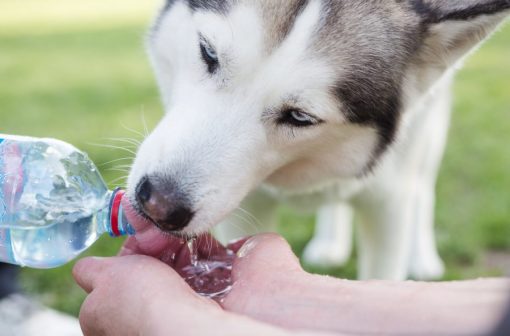This year, the highest temperatures ever have been recorded in Europe.
While the world is trying to understand the possible reasons for these heat waves, we find ourselves looking for the best ways not to let the heat interfere with our daily lives or with our holidays.
Very often, however, this is easier said than done!
Heat is a problem for us human beings – let alone our four-legged friends! For this reason it is very important for dog owners to be fully aware of the dangers that their pets run in summer.
We are obviously referring to the risk of heat stroke, also called hyperthermia. Since unfortunately animals do not speak our language, it is essential for us to be able to identify the symptoms of a possible sunstroke.
Heat strokes, when not recognized and treated in time, could even lead to death.
The symptoms of heat strokes in dogs may vary.
For example, if your dog is panting anxiously with his tongue out and then vomits, it is most likely that he has been hit by a sunstroke and needs to be taken to a cool, well-ventilated place so that his body temperature can drop.

Your dog may be tired and lazy because he is dehydrated. In addition, he may experience fainting, more or less violent convulsions, he may no longer control his bladder and bowel or he may also collapse.
Being aware of the risk your dog runs in summer can help you prevent hyperthermia from occurring. One of the most effective ways to protect your four-legged friend is to make changes to his diet, enriching it with liquids, vegetables and moist food.
Normal Body Temperature for Dogs
Heat represents a very serious danger for your pet, because dogs have great difficulty in regulating their body temperature.
In fact, our four-legged friends have very few sweat glands and that is why, to lower the temperature of his body, they breathe with their tongues out.
However, by doing so their body water evaporates, causing loss of liquids and, consequently, dehydration.
The most reliable way of understanding if your dog has suffered a heat stroke is to measure his temperature.
Dogs’ normal body temperature is between 37.2 and 39 °C. Puppies and small dogs tend to have a slightly higher normal body temperature – on average half a degree – if compared to adult or larger dogs.
If your dog’s temperature is above 40/41 °C, his blood will tend to flow towards the more superficial parts of his body, thus leaving his internal organs with insufficient blood flow.
This could lead to very serious breathing difficulties, which can also be fatal.
It is also important to know that some breeds are much more sensitive to heat than others: Bulldogs, Boxers, Beijingers – i.e. dogs with a slightly squashed snout – Newfoundland, St. Bernard, Collies – i.e. dogs with a particularly thick and thick coat.
The most reliable way to find out the temperature of your dog is by using a rectal thermometer specifically made for animals.
If you realize that your pet is actually having a heat stroke, take note of its temperature, contact the vet and give him all the information at your disposal.
This will allow him to prepare all the necessary tools to treat your dog.
How to Treat Heat Stroke in Dogs
One way to recognize hyperthermia is to check your dog’s mouth: a clear sign of this condition is red tongue and pale gums.
Other symptoms are diarrhoea, excessive salivation and increased heart rate.
Also, if your dog is exhausted and looks disoriented, it is most likely because of the heat and the sun.
The first thing to remember in this kind of situation is that you have to keep calm.
This will allow you to be able to manage the situation in the best possible way and will help your four-legged friend stay calm as well.
If hyperthermia hits your dog during an outdoor walk, take him to a cool, well-ventilated place, possibly indoors – in extreme cases, shade will also do.
The next step is to make him drink water, avoiding giving him too much at once. Moreover, remember to wet its ears and snout.
In summer it is advisable to always carry some water with you in order to keep your dog constantly hydrated and to be able to wet his head and body to prevent his body temperature from rising excessively.
If water is not helping your dog, you could try wetting his foot pads and armpits with alcohol.
Make sure, though, he does not ingest it by mistake. If your dog continues to feel sick and does not recover, it is best to contact the vet as soon as possible.
Better safe than sorry. Therefore, finding out what measures you can take to avoid these unpleasant situations for yourself and your four-legged friend is the best plan of action.
Keeping your dog in a well-ventilated, sun-protected place is not only useful in case your four-legged friend is having a heat stroke.

Whether you are used to leaving your dog in your home or outside, always make sure there’s enough air flow, that the temperature is not too high and that he always has accessible water to keep himself hydrated.
You should also avoid taking your four-legged friend outside during the hottest hours of the day, and instead try to take your outdoor walks in the morning and in the evening.
If you can’t help but go out when it is particularly hot, make sure you always have a bottle of fresh water with you. In any case, the important thing is to respect your dog’s rhythm.
Another useful tip is to remember to take your dog to the hairdresser’s during summer.
For the same reason it is also important to shear your dog. Long, thick hair is like a fleece blanket in summer – annoying, bulky and retains the animal’s body heat.
Dog Ice Lolly
It is now clear that dogs suffer from heat, almost more than man. They become frustrated, just like us, when they can’t express to their owners the discomfort they feel.
Therefore, it is important for you to be able to recognize abnormal behavior so as to calm your trusted friend.
A good way to calm your four-legged friend down is to give him a dog ice lolly: dogs love it! Making dog ice lollies is very simple, and it’s without a doubt an original and nice idea, which will allow you to refresh your four-legged friend summer.
The secret is to use fresh ingredients such as seasonal fruit and vegetables. Whether it’s strawberry, kiwi, banana, melon and strawberry, orange or carrot flavoured, ice lollies are fresh and healthy snacks.
Can I Leave my Dog in the Car?
Unfortunately, it often happens to hear or to read – especially during summer – of dogs’ death because they have been left in a car.
This unpleasant situations are, without a doubt, the doings of distracted or careless pet owners who do not care about the health of their four-legged friend.
Leaving dogs in cars is a crime.
Italian law contains rules that punish such abusive behaviour, thus protecting dogs as they are considered to be living beings, part of our families, with their own rights to all intents and purposes.
Leaving your dog in the car to do quick errands is not allowed. Remember to always carry your dog with you.
In recent years the legal regulations in this regard have become more substantial and restrictive against those who do not respect them.
The two, most common criminal sanctions are:
- cruelty to animals, which is punished with imprisonment for a period of three months to eighteen months or with a fine of 5,000 to 30,000 euros;
- abandonment of animals, which is punished with imprisonment of up to one year or with a deposit of 1,000 to 10,000 euros.
Dogs are said to be “man’s best friend” – but is it true the other way around?
If you come across a neglected, abused, abandoned or unattended dog locked in a car, call for help.
Before intervening, analyse the situation to see whether to act drastically by breaking the window.
Before doing anything, however, use your mobile phone to take videos or photos in order to prove that the situation is serious.
It is important to respect dogs and their rights as living beings, especially in summer.
